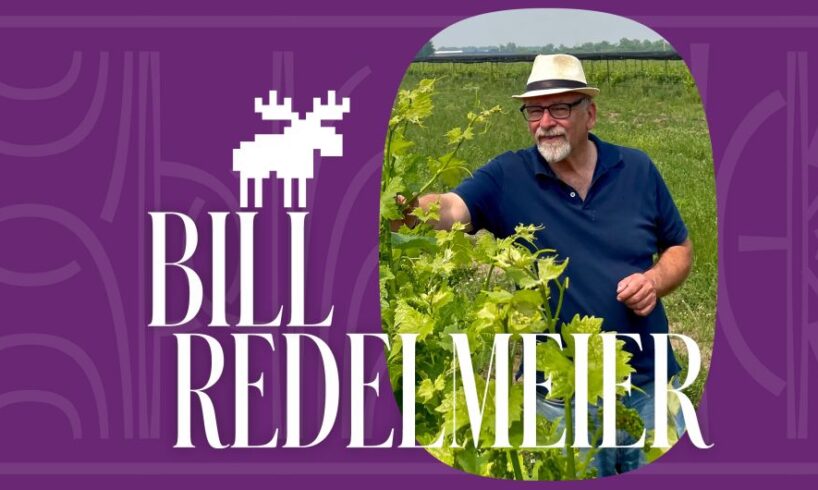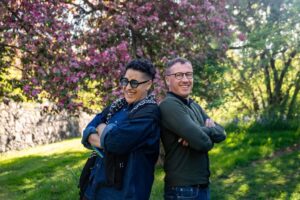
One rainy September day in 2008, Bill Redelmeier found a large salmon on the driveway of the vineyard he had opened that summer. The property is just 10 kilometres from Lake Ontario in Niagara-on-the-Lake, Ont., and the fish had likely ended up in a storm-water ditch as it swam up a creek to spawn.
“If a salmon can come up river, all of the pollutants can go down river,” Redelmeier remembers thinking. The travelling fish reinforced his vision: to transform his grape farm into a place that gave more to the land around it than it took.
Today, Southbrook Organic Vineyards is planted with not just vines, but milkweed to attract pollinators and native plants to prevent soil erosion. Those same wildflowers and grasses line the drainage ditch to make what’s called a bio-swale, filtering storm-water so that by the time it makes it back to the lake, it’s actually drinkable.
That’s just one way Redelmeier’s dream has become a reality. This year, the vineyard became Canada’s first “triple crown” winery, adding regenerative certification to its organic and biodynamic designations. The difference, Redelmeier says, starts with the soil.
“Because we’re pushing the price of agricultural products down, farming has become extractive, almost like mining.” A focus on big yields has caused a loss of organic matter in the soil, he says, which reduces fertility. Regenerative farming aims to reverse that.
Redelmeier grew up on a farm just an hour’s drive from downtown Toronto. He’s worried about food sovereignty for decades, as pavement increasingly covers places in southern Ontario that used to grow things we can eat. He’s also concerned with the bigger picture.
“It’s talking about people as well. We have to be able to certify that everybody who works for us makes more than a living wage,” he says.
Here’s what else he had to say about his relationship with the natural world in our Moose Questionnaire.
Illustration: Shawn Parkinson / The Narwhal
This interview has been edited and condensed for length and clarity. All opinions are the subject’s own.
What’s the most awe-inspiring natural sight you’ve witnessed between the Pacific, Atlantic, 49th parallel and Hudson Bay, i.e. Canada?
We as Canadians tend to look down on Niagara Falls, and in most cases I do, but there is one spot on the boardwalk where you’re standing five feet away from the brink of Niagara Falls. You see the water rushing faster and faster towards you, and then it just disappears.
We assume that Niagara Falls is really loud — the crashing waters. But that’s when the water lands, not when it goes over the edge. It’s almost a silent video of this huge amount of water disappearing, and because you’re right next to the falls, you’re not seeing all the people, all the tackiness, all the tawdriness of Niagara Falls.
What is the most awe-inspiring natural sight you’ve seen outside of Canada?
My wife and I were lucky enough, back just before our kids were born 35 years ago, to go to Mount Everest on the Tibet side. Almost everybody goes to the Nepal side.
It’s dirty, it’s messy, it’s crowded, but at that point, they had just reopened it. We were with a group who had summited it a couple of years earlier, and were invited by the Chinese government to have a walking expedition. So we walked up to about 21,000 feet [6,400 metres], standing on the slopes of Mount Everest. I have a picture of me standing there, slightly woozy, but with Mount Everest behind me.
Canadians tend to look down on Niagara Falls, Redelmeier says. And he does, too — most of the time. But he’s found one special spot where he can enjoy them without ”all the tackiness.”
Think of three iconic Canadian animals and choose one each to kiss, marry and kill.
Even though our philosophy is that we don’t try and kill anything, but try and get them not to bother us as much, the kill is the mosquito. I’ve been married for 47 years, and I think I would like to remarry my wife — she’s an iconic Canadian. Kiss? I was going to say narwhal, but I’m not sure that’s really the right one.
Name a person or group doing something meaningful for the environment that you think everyone should know about.
Gavin Pitchford and the Clean 50, which awards leaders in sustainability across Canada. It’s a fairly large group of alumni, of which we are one. We got our award because we were turning winery waste pumice into a high-antioxidant food supplement called bioflavia.
It’s just inspiring to see all the different things. The most exciting part of it is they’re picking people under 30 as well. So future leaders, future entrepreneurs.
Who is a person or group you think could help mitigate the climate crisis if they really wanted to?
Well, I mean the obvious one, Mr. Trump. But he doesn’t want to, so it’s a trite answer and not a very satisfying one.
I think anybody — everybody — can and should. It’s not one change that’s going to solve all of the problems. It’s 1,000, it’s 100, it’s one or two little changes that everybody needs to make. And that’s really the important thing.
As we’ve found, every time we think we’ve solved a huge number of problems, it creates extra problems. One hundred years ago, 75 years ago, the pesticide DDT was looked at as the magic bullet to kill all of the mosquitoes, not just the ones I want to kill. But there’s ramifications.
Everything is so related that it has to be 100 little things as opposed to one big thing. We as environmentalists keep hoping there is a single magic bullet that is going to fix all of the problems. And there isn’t. It’s a whole bunch of small things.
Bill Redelmeier believes everyone can contribute to making the environment more healthy. At Southbrook Organic Vineyards, he aims to grow grapes using a regenerative method that gives more back to the surrounding land than it takes. Photo: Supplied by Southbrook Organic Vineyards
Outdoor cats, yes or no?
Yes, but only if they’re neutered.
Tell us about a time that you changed your mind about something, environmental or otherwise.
I’m not going to have anything specific, but travel. The more you travel, the more you see the way other people do things. If you’re at home and comfortable, you expect everybody else to change. But if you’re travelling, you’re discovering new people and you’re accepting.
I mean, there are some people that travel and expect everything to stay the same as well. But especially when you’re young, if you’re travelling, you’re starting to learn about other people. You’re learning that you’re not correct on everything. That, to me, is the most important thing.
Tell us about a time you tried to change someone else’s mind about something, environmental or otherwise.
I’m trying to do it all the time. When you come and visit the winery, we have a green map outside showing about 25 different small things. We’re talking about bat boxes. Things like our solar power, which we’re replacing 85 per cent of our total annual electrical use with. The bio-swales, which handle all the surface runoff [from the property] and clean it before it gets back to Lake Ontario. Wildflowers and pollinators, kestrel houses and a whole bunch of little things we’re doing.
You don’t want everything to go so fast people get to the destination before they realize they’re on the road. So the green map is there as a speed bump to force people to stop before they come in. Ideally they look at some of the things we’re doing and will also copy some of those ideas. It gets people in the mindset of what is possible. We’re always trying to change everybody’s mind.
Rocky Mountains or Great Lakes?
Great Lakes, because the effect of the Great Lakes is larger for a larger number of people. I mean, we’re in a watershed of, what, 100 million-ish? Whereas the Rockies, they’re gorgeous, and I love the mountains, but it’s more of a solitary thing.
Redelmeier grew up in the Great Lakes region, still lives there today and wouldn’t trade them for the Rocky Mountains. Photo: Christopher Katsarov Luna / The Narwhal
Researchers at Yale University, the France-based Women’s Forum for the Economy and Society and other institutions have found women tend to be more concerned about climate change than men. Why do you think that is?
I’m not sure how to clean this one up, but because they don’t think with their dicks.
If you could dip a toe off Canada’s coastline, which ocean would it be in?
Arctic.
What’s a beautiful or useful thing you’ve owned for a really long time?
When I was about 10, my mother gave me her father’s dresser, and I still use it every day. I think of her and I think of my grandfather. He passed before I was born, but I love the heritage of it and the fact that it hasn’t gone into the landfill in the last 125 years. And I hope it will not go into the landfill. It’s useful, and it’s well made enough. It’s been repaired a few times, but it’s still beautiful.
What is the farthest north that you’ve ever been? What did you do there?
Tuktoyaktuk, and I regret not dipping my toe. I did put my hand in the water.
I was on a trip with my father when I was about 19. I drove him to Dawson City, and then ran into a friend of my brothers who was leading a group going up to Aklavik and Tuk. This would have been ‘72. During the Canada-Russia hockey series.
We were talking to the principal of the local school, and he said, ‘Well, we do take days off when somebody sees a whale and everybody goes and tries to catch it.’ It was just such a different idea. We went into a pingo. They’re sort of frozen dimples on the earth. They’d made a curling rink, and it was being used as a communal freezer. It was just so different from what we had been seeing in southern Canada.
If you could ask one person alive or dead their thoughts on climate change, who would it be?
I would love to sit down and have a relaxed evening with David Suzuki. I’ve heard him speak — he’s incredibly moving and he’s a wonderful speaker. But I’d love to have that one-on-one conversation and just ask him where he’s coming from. I think we’re similar ages and similar generations, and I’d love to talk to him.
Southbrook Organic Vineyards became Canada’s first “triple crown” winery earlier this year after it added regenerative certification to its organic and biodynamic designations. Photo: Supplied by Southbrook Organic Vineyards
Smoked salmon, or maple syrup?
Maple syrup. Not only do I like maple syrup better, my first job off the farm as a 12-year-old was making maple syrup up in Thornhill.
It comes back to food sovereignty. I’m not a huge fan of farming salmon and wild salmon is wonderful but threatened, and so has to be managed properly, but a properly managed sugar bush? The bush I was working in had been in the same family since 1804. This would have been in the ‘60s. So it had been managed by the same family on a long-term basis.
That’s the way we have to manage farming, soil, that sort of thing. It has to be on a long-term basis, as opposed to a short-term basis. That’s what regenerative farming is all about. So actually maple syrup is a really good example of that.
Who in your life has had the greatest impact on your connection to nature?
It was my mother. She was a botanist and a geographer, and both of those led to a love of nature. She had to identify everything, and usually in Latin. She was one of the founders of the Richmond Hill Naturalists Club, which gave us an opportunity to explore on a more directed basis.
As kids, we were out in the forest and stuff like that. But it wasn’t just wandering around. It was identifying. I still find that one of my joys is driving through farmland and just thinking, ‘Why does everything look the way it does? Why do we have lilacs there?’ Well, that’s because chances are there used to be a farmhouse there. Yeah, so that was certainly my mother.
Would you rather be invited to Victoria and David Beckham’s Muskoka cottage, or Harry and Meghan Sussex’s B.C. escape?
Muskoka. We grew up with a cottage in Muskoka. I love it, but I’m not sure I like it as much now as I used to.
I was invited to one of my old high school classmates’ cottages a couple of weeks ago, on Lake Muskoka. It was interesting driving around in the boat, looking at the settlement patterns. In about 1970, cottages changed, so anything prior to 1970 was lots of small rooms, but the most important part was screened porches. And then around 1970, all of a sudden, everybody put central air conditioning in when they were building cottages. The windows are smaller, the rooms are larger, but there’s fewer rooms because you’re not inviting as many people and there’s no more screen porch. It just doesn’t appeal.
The old joke was, if you owned a lawn mower, it was no longer a cottage. And now there’s more toys in Muskoka, and I don’t think people are outside.
Camping, yes or no?
Camping for those that want it, and certainly for kids.
I remember at four or five years old, I would go up to a camp in Haliburton where we canoe-tripped. It was a wonderful upbringing. For a lot of people, it creates that relationship with the outside that will last forever. If you’re growing up and you never have the opportunity to go camping, then you don’t care if Ontario Premier Doug Ford wipes out a whole bunch of areas. But if you’ve been there, even if it’s years ago, you now are invested in that area. You’re more likely to jump up and down and say, ‘No, I don’t want that area destroyed.’





